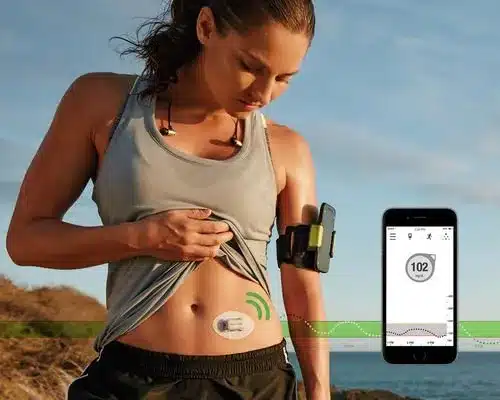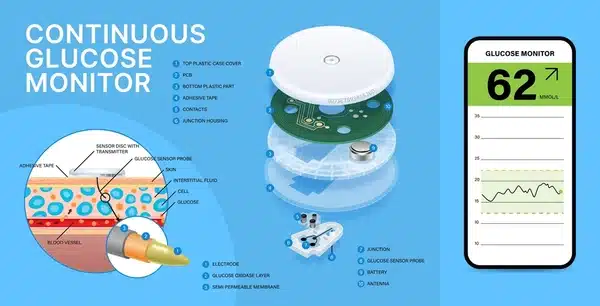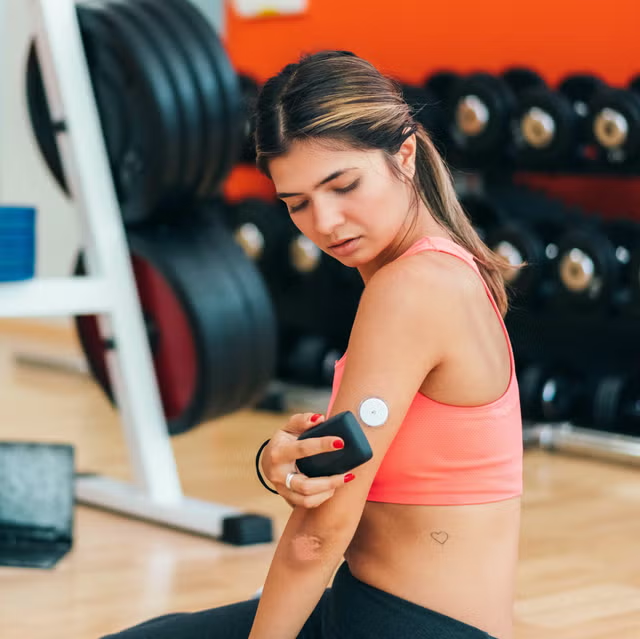Introduction: Why CGM for Fitness is a Game-Changer
CGM for Fitness is revolutionizing how athletes, fitness enthusiasts, and everyday exercisers approach training and performance. Unlike traditional glucose monitoring, continuous glucose monitoring (CGM) provides real-time feedback on blood glucose levels, allowing users to make informed decisions on fueling, training intensity, and recovery. With CGM technology, you can monitor how your body reacts to workouts, meals, and rest, giving you an unprecedented edge in optimizing your fitness journey.
In this article, we’ll explore the top benefits of using CGM for fitness, from enhancing endurance to minimizing fatigue. Whether you’re a CrossFit enthusiast or a runner, understanding your glucose levels can lead to better results and a healthier approach to fitness.
Table of Contents
1. What is CGM, and How Does it Work?
CGM, or Continuous Glucose Monitoring, is a technology that measures your blood glucose levels throughout the day, providing valuable insights into your body’s unique responses to various factors like exercise, food, stress, and sleep. A CGM device typically involves a small sensor attached to the body, which tracks glucose levels in real-time. This data can be accessed through a smartphone or wearable device, giving you instant feedback on your metabolic responses.
For those looking to take their fitness to the next level, CGM offers more than just a medical tool. It has become a popular resource for optimizing athletic performance, tracking recovery, and adjusting training plans based on glucose fluctuations.
2. Why CGM for Fitness is Essential for Optimal Performance
Using CGM for Fitness can help athletes fine-tune their training programs. When you understand your glucose patterns, you can identify the best times to fuel, train, and rest. Proper glucose management ensures that your body has the right energy available, preventing mid-workout crashes and supporting sustained endurance. This becomes especially valuable for those involved in high-intensity activities, such as CrossFit or endurance sports.
3. CGM Helps Prevent Fatigue and Boost Endurance
One of the key benefits of CGM for fitness is its ability to help prevent fatigue. Glucose is the body’s primary energy source, and low glucose levels during exercise can lead to exhaustion. By monitoring glucose in real time, you can prevent these energy dips by adjusting your fuel intake as needed. This makes CGM an invaluable tool for maintaining endurance during prolonged or intense workout sessions.
Internal Link:
Check out our CrossFit Endurance Training Guide to learn more about building stamina and incorporating CGM insights into your program.
4. Improve Workout Recovery with CGM for Fitness
Recovery is crucial for long-term fitness success, and glucose levels play a significant role in it. High-intensity workouts deplete glycogen stores, and it’s essential to replenish them to prevent muscle breakdown. CGM allows you to monitor how your glucose levels respond post-workout, helping you identify the best times to eat and what types of foods promote optimal recovery.
5. CGM Provides a Personalized Approach to Fitness
Everyone’s body is unique, and CGM for fitness acknowledges that by offering personalized insights. Unlike generic workout plans, CGM helps you understand your unique glucose patterns. You can make informed adjustments to your diet, exercise routines, and even recovery strategies, all based on real-time data.
6. Optimize Fat Loss with CGM for Fitness

For those focused on fat loss, CGM can provide insights into how their glucose levels respond to various foods and workouts. By keeping glucose levels stable, you can promote fat-burning and avoid spikes that might interfere with your goals. CGM helps track how certain meals impact glucose, enabling you to make adjustments for steady fat loss.
Internal Link:
For more tips on optimizing fat loss, check out our article on CrossFit Nutrition Tips tailored to boost performance and results.
7. Improve Sleep and Recovery through CGM Insights
Good sleep is vital for recovery, and blood glucose stability plays a crucial role in sleep quality. CGM for fitness allows you to monitor how late-night snacks, intense evening workouts, or other factors may disrupt glucose levels and interfere with restful sleep. Understanding these patterns can help you make lifestyle changes that enhance both recovery and overall health.
8. Take the Guesswork Out of Carb Loading
Carbohydrates are a primary energy source for high-intensity workouts, but timing and quantity are crucial. Using CGM, you can identify the ideal amount of carbohydrates you need before a workout without risking a glucose spike. This personalized approach can lead to better performance during training sessions, giving you the energy needed without the risk of fatigue.
External Link:
To understand more about effective carb loading, refer to MobilityWOD’s comprehensive guide.
9. Enhance HIIT Performance with CGM Monitoring
High-intensity interval training (HIIT) demands rapid access to energy, and glucose plays a crucial role in fueling these workouts. By using CGM for fitness, athletes can track how their glucose levels respond to different HIIT protocols. This enables you to optimize fueling strategies, ensuring you have the energy required to perform at your best in each interval.
10. Benefits for CrossFit Athletes: CGM for Fitness and Strength Training
Strength training and CrossFit routines rely heavily on glycogen stores. CGM allows athletes to monitor glucose levels before, during, and after strength-focused workouts, optimizing fuel intake and enhancing muscle recovery. With CGM, you can pinpoint when to consume carbs for maximum strength gains without disrupting blood sugar balance.
Internal Link:
Learn more about CrossFit Strength Training and how CGM can improve performance.
How to Get Started with CGM for Fitness

Ready to start using CGM for fitness? Begin by consulting with a healthcare provider to ensure it’s a suitable tool for your fitness goals. There are several CGM devices on the market, each with different features tailored for athletes, fitness enthusiasts, and those new to glucose monitoring.
External Link:
Visit the official CrossFit website for more insights into using health technologies for performance improvement.
FAQ: CGM for Fitness
What is CGM, and how does it benefit fitness?
CGM stands for Continuous Glucose Monitoring, a system that tracks blood glucose levels in real time. For fitness enthusiasts, CGM helps optimize fuel intake, monitor energy levels, and improve recovery based on glucose insights.
Can anyone use CGM for fitness?
While CGM is generally safe, it’s best to consult a healthcare professional to ensure it aligns with your health and fitness goals, particularly if you have any medical conditions.
How does CGM improve workout performance?
By tracking glucose levels during exercise, CGM allows you to adjust fuel intake to avoid energy dips and optimize performance, especially during high-intensity or endurance workouts.
Is CGM suitable for weight loss?
Yes, CGM can help those on a weight loss journey by identifying foods and habits that cause glucose spikes, allowing for more controlled and effective fat-burning.
What are some popular CGM devices for fitness?

Popular CGM devices include the Freestyle Libre, Dexcom G6, and Eversense, each with unique features suited for different user needs.
How does CGM help with recovery?
After intense workouts, CGM can show how your glucose levels react to post-workout nutrition, helping you time your meals and choose the right foods to restore glycogen and promote muscle recovery.
How accurate is CGM for fitness monitoring?
Most CGM devices are highly accurate for fitness purposes, although they may have slight variations compared to traditional blood glucose meters. The real-time insights, however, offer valuable trends that help optimize your training.
Can CGM help prevent fatigue during workouts?
Absolutely. By monitoring glucose levels in real-time, you can prevent energy crashes that often lead to fatigue. CGM helps you adjust your fuel intake to maintain energy levels throughout your workout.
Are there any downsides to using CGM for fitness?
The main downside is cost, as CGM devices and sensors can be expensive. Additionally, some may find wearing the device uncomfortable initially, but most users adjust quickly.
CGM for Fitness: Transforming Your Training with Science

Incorporating CGM for fitness into your training routine can be a transformative step, providing the data-driven insights needed to achieve peak performance. From enhancing endurance to supporting muscle recovery, CGM offers a personalized approach that allows you to make smarter decisions about fueling, workout timing, and even sleep patterns. As fitness technology advances, CGM stands out as one of the most valuable tools for athletes seeking a competitive edge.
If you’re ready to maximize your potential, consider integrating CGM into your fitness strategy and unlock a new level of performance based on real-time glucose insights.
Internal Link:
Discover how to improve your CrossFit Recovery Strategies and enhance performance with science-backed methods.
External Link:
For more information on CGM devices, refer to WODwell’s resources on fitness technology and explore how glucose monitoring can optimize workouts.
How CGM for Fitness Enhances Nutrient Timing and Meal Planning
One of the most powerful applications of CGM for fitness is in optimizing nutrient timing and meal planning. For athletes and fitness enthusiasts, when you eat can be just as important as what you eat. Understanding how different foods affect glucose levels in real time can empower you to make adjustments that enhance performance, fuel recovery, and stabilize energy levels throughout the day. Here’s how using CGM for fitness can elevate your nutrient timing and improve your overall approach to meal planning.
1. Fueling Workouts with Precision
CGM provides insights into how various types of meals impact blood glucose, allowing you to identify the best pre-workout foods and portion sizes. By monitoring glucose levels after eating, you can observe how quickly your body digests certain carbohydrates and how long the energy from a meal lasts. For example, some athletes may find that a meal high in complex carbs, like oats or sweet potatoes, stabilizes glucose for a more sustained release of energy, while others may benefit from a mix of fast-digesting carbs for a quick boost. With CGM for fitness, you can personalize your pre-workout nutrition strategy for optimal energy levels at the start of your training session.
2. Identifying the Best Post-Workout Meals
After a challenging workout, restoring glucose and glycogen stores is essential for recovery and muscle repair. CGM for fitness can help you choose post-workout meals that replenish glucose effectively without causing excessive spikes. Many athletes use CGM data to time their post-workout carb and protein intake for enhanced muscle synthesis and recovery. By observing how your glucose levels respond to post-exercise meals, you can identify the specific foods that help you recover best and adjust your intake to meet your unique energy demands.
3. Preventing Afternoon Energy Crashes

For those who train in the morning or early afternoon, preventing an energy dip later in the day is essential for maintaining productivity and focus. By tracking glucose levels throughout the day with CGM, you can observe how certain meals or snacks contribute to midday energy crashes. Some athletes may find that including a balanced snack—such as one that combines fiber, protein, and healthy fats—keeps glucose stable and prevents the sluggishness that often follows carb-heavy meals. With CGM for fitness, you can tailor your meal timing and composition to avoid crashes, supporting sustained energy levels all day long.
4. Customizing Carb Intake for Fat Loss Goals
When it comes to fat loss, the timing and type of carbohydrate intake can make a difference in results. Many fitness enthusiasts use CGM to experiment with carb timing, adjusting intake based on glucose responses to find the ideal balance for fat-burning. For instance, some may opt to consume most of their carbs around workout times to prevent glucose spikes at other points during the day. This approach helps stabilize glucose while still providing the energy needed for performance. With CGM for fitness, you can create a meal plan that supports your fat loss goals without compromising on energy levels or workout performance.
5. Improving Intermittent Fasting Outcomes
Intermittent fasting has become a popular strategy for improving metabolic health and fitness. However, the impact of fasting on glucose levels varies widely from person to person. By using CGM for fitness, those following intermittent fasting can gain a clearer picture of how their glucose levels respond during fasting and feeding windows. This data allows you to time your meals around periods of stable glucose, optimizing both energy levels and fat-burning potential. CGM insights can also highlight if certain foods cause glucose spikes after fasting, enabling you to make smarter food choices that align with fasting goals.
6. Tracking the Impact of Macronutrient Ratios
Each macronutrient—carbohydrates, proteins, and fats—affects glucose differently. With CGM for fitness, you can observe how different macronutrient ratios impact your glucose response. Some athletes perform best on higher carb intake, while others benefit from a low-carb or ketogenic approach. CGM insights allow you to identify the ideal macronutrient composition for your goals, whether it’s building muscle, improving endurance, or losing fat. By experimenting with ratios and tracking glucose responses, you can design meals that fuel performance and align with your body’s specific needs.
7. Tailoring Nutrition for Rest Days
On rest days, your energy expenditure is lower, and your glucose requirements may change. CGM helps adjust meal timing and composition to avoid unnecessary spikes in glucose when you’re not as active. This approach supports metabolic health and ensures that rest days contribute positively to your fitness goals. By using CGM for fitness, you can experiment with lower-carb or high-protein meals on rest days, promoting muscle repair and recovery without excessive calorie intake. This personalized approach can enhance your results while keeping glucose stable and supporting overall health.
8. Experimenting with Different Foods and Their Impact on Glucose
Every individual’s body reacts uniquely to certain foods. For instance, one person’s glucose may spike after a particular fruit, while another person’s may remain stable. By experimenting with various foods through CGM for fitness, you can pinpoint which foods support stable glucose levels and which tend to spike your glucose. This information allows you to design meals that keep glucose consistent, leading to sustained energy levels and fewer fluctuations that may interfere with workout performance or recovery.
9. Avoiding Late-Night Glucose Spikes for Better Sleep
Late-night eating, especially of high-carb or sugary foods, can cause glucose spikes that interfere with restful sleep. Using CGM allows you to observe how your body responds to different types of late-night snacks or meals. By choosing foods that promote stable glucose levels before bed, you can improve sleep quality and recovery. With CGM for fitness, you can test the timing and type of evening meals to find a strategy that works best for restful, undisturbed sleep.
10. Fine-Tuning Hydration and Electrolyte Balance
While primarily used to monitor glucose, CGM can indirectly help athletes track hydration needs. Low glucose levels can sometimes indicate dehydration, as dehydration can impact glucose metabolism. Athletes using CGM for fitnesscan observe patterns between hydration, glucose stability, and overall performance, adjusting their water and electrolyte intake as needed. This fine-tuning ensures that you’re not only fueled but also optimally hydrated for peak performance and recovery.
Closing Note: At CrossFit Angier, we’re dedicated to helping our members reach new heights in their fitness journeys. If you’re interested in using technology like CGM to improve your performance, our team is here to support and guide you.
Through each of these strategies, CGM for fitness transforms how athletes approach nutrition. Rather than following a one-size-fits-all diet plan, CGM enables you to understand and adapt to your body’s unique responses. By timing meals strategically, adjusting macronutrients, and making informed decisions on pre- and post-workout nutrition, CGM empowers you to enhance performance, recovery, and long-term health.
For those serious about maximizing their results, CGM for fitness offers a new level of personalization. With real-time insights guiding your approach to food and training, you’re no longer guessing but rather making data-driven decisions that support your fitness journey. Whether your goal is fat loss, muscle gain, or improved athletic performance, CGM helps you reach your potential by unlocking the science behind optimal fueling and recovery.



